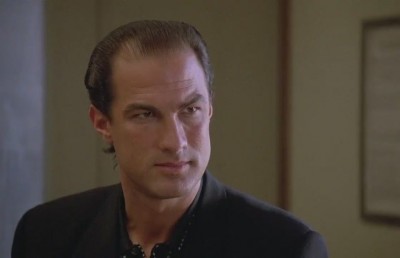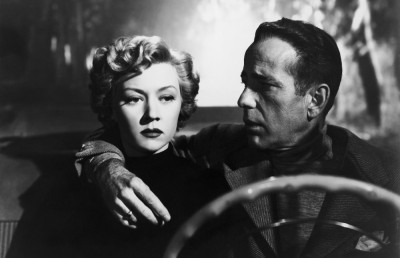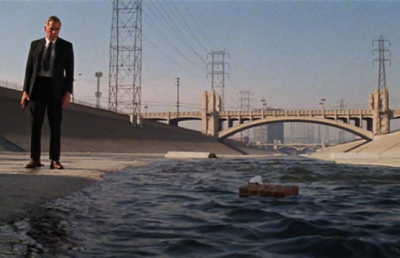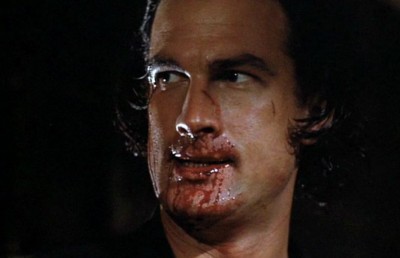I Knew You Before I Ever Saw You: In a Lonely Place (1950), Part 1
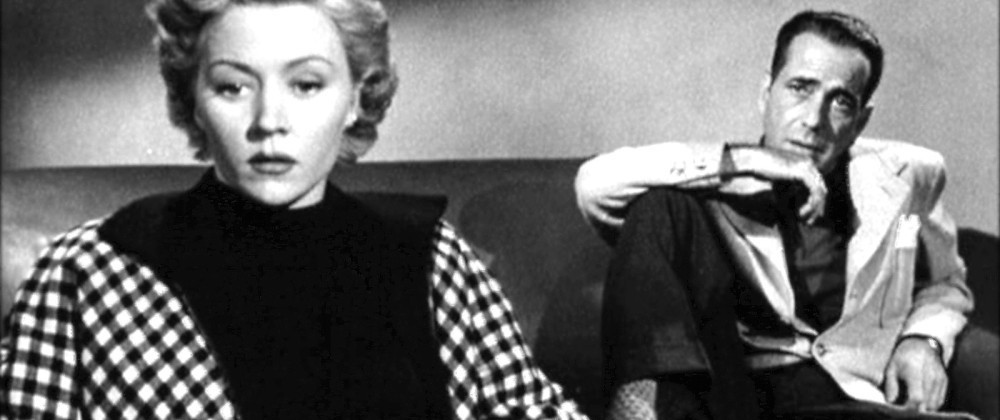
“He had needed her for so long a time. He had always needed her.”
(Hughes, 1947: 64).
The film In a Lonely Place (1950) occupies a special position in the history of psychological film noir. It is a movie-movie, a self-referential examination of Hollywood life by one of its own – a screenwriter desperate for work is suspected of murder and is saved, temporarily, by the woman who gives him an alibi. It is a great romance which plays second fiddle to a murder investigation hanging over it like a burdensome dark shadow. It is a bleak exercise in noir starring one of Hollywood’s greatest stars at the height of his powers in a role which he chose and tailored for himself. He brutalises his own complex heroic 1940s reputation in a film which asks questions about how we measure a man – by his behaviour, his profession and the work he produces, his past, his true character, whatever that might be and howsoever it might materialise, by the accusations levelled against him, or by his friends?
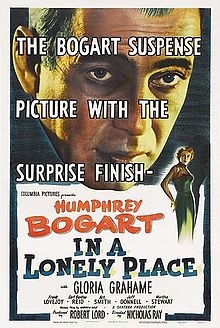
The original poster
Adapted by Edmund H. North from the novel by Dorothy B. Hughes, with a screenplay by Andrew Solt, Humphrey Bogart acquired the property for his own production company, Santana. It is not just a film noir, or a crime thriller, it’s also a film about making films and it is a film about a city, Los Angeles, which is emphasised in the film’s very first shot. Bogart had worked with Ray on Knock On Any Door (1948) an adaptation of black writer Willard Motley’s acclaimed novel. Bogart had chosen the hefty tome as his first production and Ray as his director: Motley was blacklisted and finished his days living in exile in Mexico. Bogart’s empathy with victims of the Hollywood witch hunt was always public if ultimately complicated and it never risked his place in the film hierarchy – 1948 was his highest earning year to date and he was in the Top Ten several times during that decade. ??Knock??… was an almost sociological examination of crime in which Bogart essayed a mentor or father-like figure to a juvenile delinquent played by John Derek. Director Nicholas Ray was himself saved from blacklisting by the personal intervention of Howard Hughes at RKO (Hughes didn’t bother doing the same for either John Cromwell or Joe Losey) and it is likely that Ray testified (if somewhat misleadingly) at some level in order to continue working. He owed Hughes his career.
The first image we see of Dixon Steele is Bogart’s eyes – haunted, hunted, paranoid – in the rear-view mirror as he drives through Los Angeles at night. This is a city that is fascinating to watch on film. He takes us through West Hollywood with a first person perspective from his 1946 Lincoln Continental. The eye he casts upon the city is caustic, bleak and war-weary. Dixon is a damaged man and Ray wants us to know it: he placed small lights on Bogart’s eyes to emphasise the importance of perspective in the narrative. We are supposed to empathise with him and we are led to view the proceedings from his point of view, despite everything we subsequently learn. [1] The significance of the image within the image is not yet important; it gains its role in retrospect in a narrative which places smaller narratives within the larger whole in order to impart context. This is a story of storytellers and the mess in which they find themselves when other, less cultured, people apparently misread their narrative intentions.
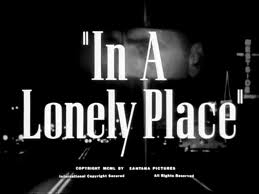
The jaded point of view of the protagonist
We follow Dix to a restaurant called Paul’s, based on Bogart’s own restaurant of choice, Romanoff’s – they have similarly fake-accented maître d’s – and he is accosted by autograph hunters. He utters the existentialist’s plaint: “Who am I?” before signing. We watch him get very drunk and violent, insulting a director, chiding his agent, punching the jumped-up son-in-law of a studio head and generally conforming to his lengthy reputation for brawling. It is clear he is a victim of the Hollywood environment – unsafe outside the confines of his apartment and perhaps dangerous to others, too. What is also clear is that he is burnt out. His worst instincts are provoked by denizens of the industry; his habitual failure to pick up the phone (it’s an offer of work) a narrative rhyme that will pay off later on in one of the many ironic touches on which the story pattern is constructed. The people who witness his outburst are accustomed to it and comment on him: in Hollywood, everyone’s a critic.
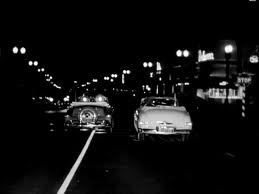
The 1946 Lincoln Continental
Themes of identity and morality, as well as the pitfalls of Hollywood celebrity and the dangerous business of a dependence on the vagaries of employment in the film industry are the subject of the narrative, as well as the primary plotline of guilt or innocence and a crime investigation. The construction of the screenplay conforms to classical Hollywood style – it has the two lines of narrative, the primary plotline being the murder story and investigation; the secondary plotline being the typical Hollywood romance. The two lines of action interlink in a chain of cause and effect while the protagonist is distinguished by his desire to achieve a certain goal, the one line expressing an outer-directed goal, the other expressing something more personal. The well-made play is the source of the classical Hollywood screenplay and In a Lonely Place is a masterful example of tautly-plotted writing in the classical style (although the rather unformed category of noir is in itself regarded as a disruption of its assumptions.) (Bordwell, Staiger and Thompson, 1994: 16-17) However the film certainly adheres to the idea of the interrogation of the post-war period, the incorporation of psychoanalysis as a national talking point (courtesy of the CIA) and the expressionistic visuals. Meaning is thus produced on a number of levels both intrinsic and extra-cultural, while the process of realist generic representation, over-determined as it might be in the heightened manner of late-40s mannerism, is still contained within the classical Hollywood style by the storytelling rules long established in the melodramatic mode and the police procedural motif (which is a useful template for organising the material), as well as the limited point-of-view narrative, a pattern both within the hard-boiled subset of pulp fiction and the film noir style itself. However the investigation is quickly relegated to the level of fiction because it is the fiction writer, Dix, who solves it, in front of the police officers (they should be looking for someone like him but without his artistic qualities, he informs them); he also suggests (in front of him) that they should be looking at Mildred Atkinson’s boyfriend, who is in his view the most logical suspect; and he solves the crime in front of Brub in the re-staging based on his knowledge of crime thrillers. The film sets the police up for a fall: thus the convention of the hard-boiled detective thriller is deflated repeatedly. It is the screenwriter who understands the nature of the criminal and he who tells the story best. And it is he who ends up shaking the hand of the killer. So the conventional structure is subtly reversed while being overtly respected.
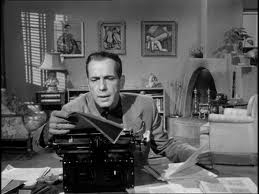
Dix checks pages at Laurel’s apartment
Hollywood in the 1940s was a dark place – literally and metaphorically. The war had taken some of the gloss of the business. There had been a horribly divisive strike at the Walt Disney Studios. Profits had suffered after the boom year of 1946. The Paramount Decree ensured the divestiture and separation of production, distribution and exhibition arms of the business. The House Un-American Activities Committee created fissures amongst friends and colleagues that never healed: Bogart was the biggest star to march on Washington in support of the Hollywood Ten even if his views on the situation were ultimately rendered problematic by developments and actions by the victims themselves (whose inconsistency led to immense frustrations amongst their supporters). Bogart was therefore familiar with the annoyance felt by many at the actions of men who, under surveillance, threat and vocal accusation, behaved in ways that aggravated the people who went out of their way to back them. He empathised with their situation. Studio politics were now on the national stage. Actors were beginning to take more control of their careers under the aegis of agents like Lew Wasserman. It was also a dangerous town for women: the grisly Black Dahlia murder had taken place in January 1947 (immediately prior to the publication of the novel by Hughes) and the overall climate of the post-war era was perceived to be one of masculinity in crisis. The out of work veteran was steadily becoming a creature to be feared, a man out of control, while women were taking jobs previously assumed to be men’s. There was a moment in the culture when a space became viable for the hard-boiled subset of crime or pulp fiction – this was it. In a Lonely Place fits into that cinematic phase described by Paul Schrader as “the period of psychotic action and suicidal impulse” in which “…the forces of personal disintegration are reflected.” (Schrader, 1972).
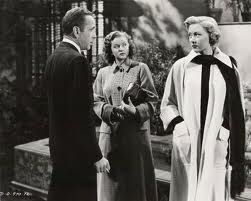
Laurel lays eyes upon Dix and Mildred
Dixon Steele was Bogart’s bleakest role in a career studded with the modern take on humanity’s infinite behavioural dilemma – how to be a man. As ruthless as Fred Dobbs in Treasure of the Sierra Madre (Huston, 1948), as crazy and psychotically conflicted as Geoffrey Carroll in The Two Mrs Carrolls (Godfrey, 1947), as savvy and sardonic as Philip Marlowe in The Big Sleep (Hawks, 1946), as complex and sympathetic as the pragmatic Rick in Casablanca (Curtiz, 1942), he is infinitely complex and wavering, with a fleet of loyal friends and disbelieving women nonetheless drawn to his charismatic way with a story – and his face. What a face. His character type evolved over a long period but might be truly said to have been reinvented with his portrayal of ‘Mad Dog’ Roy Earle in High Sierra (Walsh, 1941). Like Earle, Dixon Steele finds himself outside his comfort zone – his future is in the past. He hasn’t written a hit since before the war, as he is regularly reminded. Earle dies to save the dog he has neglected; Dix neglects his agent; he hasn’t called his friend Brub in a year; and he constantly mis-reads the signs of disenchantment and fear in Laurel. The very first scene has Dix pull up to lights at a junction between Fountain Avenue and North Harper and a woman in the next convertible automobile reminds him that she was in his last picture, to which he retorts, “I make it a point never to see pictures I write.” The man accompanying the woman takes exception to Dix and threatens to beat him up. Dix invites him to do it right there. Thus the pattern is set: Dix is a writer who’s not proud of his work, he’s attractive to kept women, he’s capable of making other men jealous, and he is prone to reacting with hair-trigger temper to the slightest provocation and in fact goes out of his way to pick a fight with an obvious contender. He then apologises profusely for his response (albeit not in this particular instance). The overall effect is to establish a paradigm of illusion versus reality, art versus life. This dialectic rhymes with the sadist-masochist configuration that reflects Dix and Laurel’s relationship. His former girlfriend, Fran, admits he was a pretty nice guy during their relationship – just not to her. The affect is of narcissism but also of cunning re-invention of his Hollywood persona. (Belton, 1994: 106).
The plot concerns washed-up screenwriter Dixon Steele’s latest commission – to adapt a dreadfully lowbrow bestseller that he has no other interest in reading. He hasn’t answered his phone in a few days. He gets a hatcheck girl Mildred Atkinson (Martha Stewart) to regale him with the story. He promises to give her money when she provides him with the synopsis (although we suspect that this is an elaborate cover for what they both understand to be a pick-up that doesn’t quite work out). He gives her money to take a cab home from his apartment when her silliness wearies him. When she is found dead, he is traced back to the club and charged with her murder. Laurel Gray (Gloria Grahame), his neighbour, provides him with a false alibi. Their acquaintance deepens into friendship and then love – but she begins to have her doubts about his supposed innocence while he is plagued by demons of his own. While the murder investigation led by his World War 2 crony Brub/Sergeant Nicolai (Frank Lovejoy) still places him as the chief suspect, his behaviour starts to become controlling and Laurel becomes fearful and distant. She admits she has attended the police station on another occasion to answer questions about him and he almost kills an innocent bystander in his resulting road rage. Laurel plans to leave him. When he finds out he starts to strangle her – and is only stopped from killing her by the ringing of a telephone, a call that ultimately proves his innocence. She leaves him.
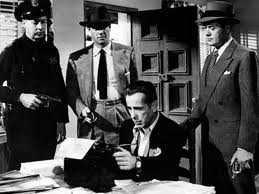
Dixon is questioned at the Beverly Hills police dept.
As in the book, we never see the actual murder of Mildred Atkinson. Instead, Dix is shown the crime scene photographs, which Ray has scrupulously staged in order to create a drama in Dix’s reaction shots (this is in fact underplayed: he is unsurprised; he has seen it all before). He is infinitely sympathetic for the poor girl’s plight but reacts with forensic humour. We wonder when we watch him: is this man Jekyll and Hyde? Perhaps with his heavy alcohol habit and hair-trigger temper, he has no recollection of murdering a celebrity-obsessed girl whose sycophancy probably disgusts him behind his relaxed devil-may-care persona (even she misinterprets his retreat into slippers and dressing gown – he is merely tired of her stupidity in this botched pickup and wants her to leave). Bogart’s subtlety raises the question but his character soothes us for now because we trust his vulnerability (and we know him from his previous films). When he re-plays the images for Brub and his wife Sylvia (Jeff Donnell) at the dinner table he is so convincing in his stage directions and his interpretation of the crime, his storytelling so skilful and enthused (and this is the second occasion when Ray lights his eyes, perhaps over-dramatically, to suggest psychotic rage in Dix) that Brub comes close to strangling his wife. Sylvia tries to persuade her husband that his former Army colleague is “abnormal”: she’s college-educated, so she should know. Her well-founded suspicions reaffirm our own unutterable view of Dix, rubberstamping the police record of brawls and beatings. However it is her own husband who portrays the potential of the average man for murder. In the novel, Hughes writes, “It took imagination to think of a man, sane as you or I, who killed.” (Hughes: 52). He might be a nobody to the autograph fiends but in the newspapers, as Mel tells him, he will be written up as the distinguished screenwriter who took a hatcheck girl home to tell him a story (and she even left out the sub-plots, thankfully.)
Effectively, the film works as a satiric melodrama on the level of the operatic and this is underscored by the composition of George Antheil, the avant-garde classical composer who had a fruitful collaboration with Ray. His work functions as a commentary on the proceedings, a gloss, a question mark, not merely accompaniment, and prompts audience reactions as appropriate, mostly based on the attitude of Dix towards his surroundings. Even though this might be said to fit into the ‘menaced woman’ subset of the noir style, Laurel is a frank and sexually forthright woman and Dix informs her that he appreciates that about her the first time she visits his apartment. Dana Polan’s analysis refers to the film’s relationship with the Gothic cycle but it is Laurel who drugs herself with sleeping pills much to Dix’s distress: he is the paranoid one, she is merely suspicious, and her troubled sleep introduces delirious nightmares that replay her worst fears (the film’s version of the noir flashback). (Polan, 1993: 21-2). On the other hand, Dix’s activities keep Mel awake at night. Gloria Grahame plays Laurel but she was not Bogart’s choice: that was his wife, Lauren Bacall, whom Warner Bros. would not release from her studio contract, probably due to his independent contract status; yet the role was especially written for her. Columbia top brass wanted Ginger Rogers but Ray persuaded them to hire Grahame, his own wife, a woman of great complexity, sexual voraciouness and difficult personal relationships in real life. She played it with great compassion and effectiveness. Ray and Grahame were temporarily estranged at the time of filming and reunited briefly afterwards. The film’s producer, Robert Lord, was extremely concerned that their marital discord could cause problems on set and had Grahame sign a contract in which she undertook to take direction from her estranged husband and not to indulge in any behaviour which would distract him or deter him from his job in any way.
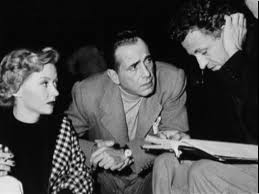
Grahame and Bogart on set with Ray
In terms of Bogart’s stardom and his own relationship with the roles he played and how he saw himself, how Dixon Steele and Bogey were suited to each other or what Bogey saw in Steele, silent film actress Louise Brooks wrote in a 1966 essay for Sight & Sound:
Before inertia set in, he played one fascinatingly complex character, craftily directed by Nicholas Ray, in a film whose title perfectly defined Bogart’s own isolation among people. In a Lonely Place gave him a role that he could play with complexity because the film character’s, the screenwriter’s, pride in his art, his selfishness, his drunkenness, his lack of energy stabbed with lightning strokes of violence, were shared equally by the real Bogart (Brooks 1966/7).
In other accounts, Bogart was a much more stable and conventional fellow, but the image he now wanted to convey was precisely what was in the content and style of Steele – a talented contrarian, an anti-authoritarian, a guy’s guy and the kind of man women like, a man who has his reasons and doesn’t see fit to explain. The fundamental irony on which the narrative rests is Dix’s occupation: if he created better scenes in his own life, things might turn out differently. His attempts at dialogue are barbed and multi-layered and directed with pointed clarity: he is clearly a wordsmith. If he weren’t so complicated, he’d be a nicer guy. If he weren’t such a good storyteller, he’d be a bad liar. If he’s such a great screenwriter, why hasn’t he had a hit in a decade? If women like him so much, why isn’t he married to one of them? And if he’s such a great storyteller why can’t he really convince the one woman who has made him her great romance? If he’s really as talented as he thinks he, is why hasn’t he been more successful, for all his distinction? Dix’s leaked screenplay clearly is not the faithful adaptation that was commissioned, it’s much better, and his producer is delighted despite Dix not wishing him to see it yet. The ironies proliferate at a rate of knots, every scene redoubling on the last, carefully plotted out to reveal more yet also to make Dix somehow even less knowable and trustworthy, more prolix and complex.
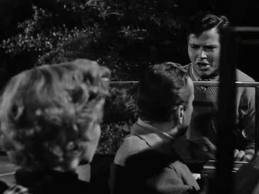
The roadside encounter with the quarterback
Bogart’s attraction to Steele is obvious –aside from the name, of course, which, as Scott Thill suggests, had a certain ring to it when reversed. (Thill, 2003). Steele is a great anti-hero – as likeable in his own way as Sam Spade or Philip Marlowe – those wonderful L.A. private eyes that Bogart had made his own and which secured his cinematic legend. The character’s ambiguity, his War experiences, his attractiveness to women (they chase him, unlike in the book where his proclivity for skirt-chasing is more obvious – and obviously sinister), his lowly role in the film business, all must have appealed to Bogart, who was determined to play more complex characters – he excelled at these but had frequently been cast in more straightforward tough-guy roles and his performances had been much less interesting as a result. David Thomson comments of his pairing with Ray:
…only In a Lonely Place came to grips with the malevolence in Bogart, or so effectively saw through the knowingness of his 1940s films. (Thomson, 1994: 615)
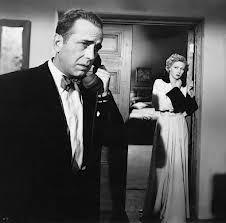
The bow-tied screenwriter
As Basinger says about the type that Bogart created, it took a long time to find, but once it was discovered, he was a star:
His career is a great example of how the actor becomes the character and the character in turn becomes the actor. After Bogie’s type was found, he grew to be a legend (Basinger, 2007: 82).
When we first see him in those opening scenes, angry, cynical, bursting for a punch-up, it is a clear commentary on those roles which secured him his place in the Top Ten of actors throughout the 1940s – a gloss on something he was now intent on leaving behind. It is a comically ironic touch but the ultimate irony is the tragic twist that this helps construct.
Director of cinematography Burnett Guffey was at the top of his form here in the spectrum of noir shooting. We are placed in doorways, window frames, mirrors, shadows, streaming light, car headlights, bars in shadow, venetian blinds, wrought-iron partitions, faux haciendas, courtyards overflowing with bougainvillea and fountains, police stations with walls covered in crime scene photos, lamplit boulevards, inside dull restaurants and outside fluorescent-lit drugstores. Dix’s ornately decorated apartment with its chintzy curtains in the lounge, exotically obtained armoires, slatted blinds, the bedroom with its plaid shades and Toby jug collection on the shelf behind the bed (how could such a man commit murder?!), the complex array of clutter festooning his life, all contribute to our understanding of someone who sometimes cannot control his reflexive aspect, a drunk who is dangerous to hire, untrustworthy in the Hollywood scene, provoked to violence by being in its festering fetid environs. The concentration of objects gives the film an impression of stasis and order; the reality of Dix’s personality is utterly different. The scenes in which he watches Laurel from his bedroom window (itself a complex symbolic pattern of slats, curtain pattern and frame) and makes a telephone call while she watches him from her balcony, suggests the actual and eventual distance between them. The courtyard that brings them into each other’s lives also signals the emotional gulf that will alienate them from each other and finally end their relationship. The final shot, an exhausted Dix departing into the florid floral background on an overhead diagonal from Laurel’s apartment, leaves us wondering, what will become of him? Where will he go now? What will he do next?
Edmund H. North did the adaptation treatment and apparently saw the character of Dixon as Hughes did – a young writer, down on his luck. Hughes created a character who was a psychopath – he kills a wealthy young man and assumes his identity and thereafter pretends to his own father that he is writing a novel. He randomly picks up Mildred Atkinson at a bus stop and murders her. There is no question that this man is an innocent. He is also a man who likes to pursue women. The novel is not written in the first person but it is a tightly controlled impression of the mindset of a serial killer, all from his perspective. John Derek was the first actor considered for the role but of course once Bogart acquired the property the tone was changed. Andrew Solt then took charge of the screenplay (he apparently never saw the North treatment and was mystified by the screen credit) and made alterations with regular contributions from producer Robert Lord and then director Nicholas Ray. Thus the film is fundamentally different from the novel. Dix is now a screenwriter and is clearly the subject of women’s interest with a more ambiguous outlook. He is the subject of the female gaze, the object of onlookers’ opinions. The cinematic text abounds with commentary based on the film industry and its workers. Dix is no longer a serial killer although still prone to sudden outbursts of rage, inevitably provoked by his co-workers, colouring the impression he makes on people. He lives in an apartment block filled with studio workers in the book but in the film he is the only so-called celebrity in the building (perhaps until Laurel’s arrival). The final script was, in Bogart’s view, perfect. However of the 140 pages in the shooting script only 4 survived without daily revisions on set by Ray. Solt was not permitted to attend the filming.
Like the novel, Dix’s predilection for violence is linked with his war experiences although in the novel this is stated quite explicitly and the backstory alludes to a murder – another woman, Brucie, whose demise clearly haunts him and in his own mind is the propeller for every other murder he commits. Some scenes that finished on the cutting room floor hint at Dix’s innocence quite early in the film. One such shows Mildred’s boyfriend Kesler following her home. Another shows Laurel watching Mildred leave. This would throw into jeopardy the perceived ambiguity of her alibi for Dix, thereby making his innocence obvious and reducing the possibility of any suspense. The film is located in the film business and could be read as a gloss on the witch hunt – Dix is placed under suspicion because of his occupation; his best work pre-dates the war (and the HUAC communist hearings); and his understanding of the drivers for violence (imagination and its problematic bedfellow, empathy) immediately place him at the top of a list of presumed aggressors. As in the novel, the detective, his former wartime colleague, is distinctly average and does not possess sufficient insight to solve the case on his own: this plot point deviates from the typical hard-boiled template and casts doubt on the ability of the police force. This distances the audience’s sympathy for the force of law and order – putting them in another distinct state of unease – and we realise it is Dix’s innate understanding of the criminal psyche and his common-sense approach to the facts of the crime that help get it solved: it takes an “exceptional” man to solve a murder case. It is his perception of the mind of a killer that lends itself to the solution, the imagination to which Hughes alludes in the original novel. We are cast back to the film’s first image when the poet of death looks at his own image in the Continental’s rear-view mirror. It is the iteration of separateness, if not the superiority of point of view.
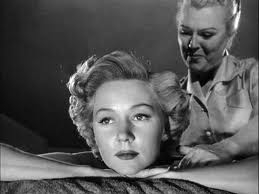
Laurel is pounded into submission by Martha
Laurel is the kind of woman who is good for Dix: her emotional support means he is no longer so dependent on alcohol and he starts to work again. (She even types his pages for him.) However such a conflicted man can never remain steady for long and his lack of self-esteem returns to haunt him, while Laurel starts to doubt him when she watches him fly into his psychotic rages. She is also damaged by her previous relationship with Baker (whom we never meet). Her relationship with Martha (Ruth Gillette), her masseuse from her studio days, adds another layer of complexity to her portrayal: Martha is a sceptic (Columbia’s less appealing answer to Thelma Ritter, perhaps) who knows how bad things were with the last man in Laurel’s life and whom she was clearly lucky to escape – although he offered her a fine house with a swimming pool added to increase its and by implication, her, value. As Dix comments, “Hollywood dames know nothing about the community chest but they know everything there is to know about community property.” This is the pattern for male/female relationships in the film: Brub and Sylvia are the exception as she is clearly the superior and better-schooled of the couple, even if his enacting of the ‘mugging’ of Mildred reveals men’s innate attitude towards women. Martha tries to persuade Laurel to leave Dix before he kills her. Martha is clearly coded as Lesbian, although Laurel explains her away as 50 and married, with a grown-up son. She is perhaps a link to Dix in the sense that she, too, is a Hollywood outsider, ostracised, even blacklisted, but for very different reasons. But she is not sympathetic to him and repeats the gossip about Fran, his previous girlfriend. A version of this is replayed between Laurel and Sylvia when Laurel apologises for Dix’s behaviour at the beach and describes the incident with the young quarterback who almost crashes into them. This is the film’s equivalent of the children’s schoolroom activity, Show and Tell. It also illustrates the difference in perception between men and women and the way in which female intuition (and redolent chatter) relays information about the male potential for violence and murder.
It is clear that Laurel and Dix have started to live together, but Mel doesn’t appear to grasp that fact: she is getting him writing again, that’s what’s important. Appearances can be deceptive. Mel is watching a performance and this is clarified by the staging of the scene in which he watches Dix writing, in longhand, from the apartment window. He observes Laurel doing the little woman act, fussing and clearing, preparing to take the pages away for typing in her own apartment. She then finds Mel watching and chides him for snooping through windows: he only takes from her performance what he requires, reassurance that his client is on the up again. He simply doesn’t understand (or chooses not to) what is in plain sight. When Mildred recreates for Dix a violent scene from the trashy novel, placing the incident at a window, her screams ‘Help! Help!’ echo through the real open windows onto the courtyard, observed by Laurel from the vantage point of her balcony, screams that might give the impression that Dix is trying to kill Mildred. It is a dress rehearsal for more than one upcoming event. As Dix cracks to Laurel, “You’re one up on me – you can see into my apartment.” The dichotomy between seeing and believing is yet another bifurcation of the narrative. And all the while the Beverly Patio Apartments’ cleaner wants Laurel and Dix to make up their minds about where they’re living so she can tidy up their respective homes.
In the Hughes novel, Dixon Steele is a serial killer and rapist. This was not a subject foreign to the denizens of Los Angeles at the time of the film’s release when there were a number of post-war crimes attributed to disturbed veterans; and rumours swirled in the industry as to who might have been the culprit behind the Black Dahlia murder (Orson Welles and John Huston were just two of the more salubrious names attached to the notoriously grisly crime). In the film we see Dix as a violence-prone, unusual individual but he does not kill Laurel – however he does in the novel and in the final shooting script, when Sergeant Brub Nicolai comes to clear him of Mildred’s murder but ends up arresting him for Laurel’s. Dix tells Brub that he has finished the screenplay and the final shot of the film was supposed to be a line of dialogue that he had said to Laurel in the car: “I was born when she kissed me/ I died when she left me/ I lived a few weeks while she loved me.” Dix is not shy of using elements of his real life in creating his art and he is making explicit the fact that Laurel has exposed his inner poet with this triadic declaration. He in fact says it is the farewell note in the film he is writing: it is a predictor of his own love affair. In the film Laurel finally quotes the third part of the line at the end – she couldn’t bring herself to do it in the car when he asks her to try it on for size – then just completes it with, “Goodbye, Dix.” This really is the farewell note: it had to be edited and rewritten, like the novel he adapts. The constant pattern imprinted here is Dix’s use of the wrong line to the wrong women at the wrong time, foreshadowing disaster. This occurs just two-thirds of the way through the running time. Nicholas Ray claimed he changed the crucial climactic plot point in which Laurel finally completes the line (which he had helped write) because he had “more interest in doing something about the violence in all of us, rather than a mass murder film or a film about a psychotic.” The ending was then improvised and shot on a closed set. This is a film about a man mysteriously damaged by his experiences fighting in World War 2. These experiences are never divulged, never explained. They are burned onto his psyche and he suffers inexplicable, violent rages, apparently as a result of a bigger war that affected everyone – at least, it is the men who really understand; the women are there for physical comfort, socialising and reassurance (and occasional typing). He is of course a poet manqué, as his enjoyable jousts of recitation with The Thespian demonstrate – Charlie talks him to sleep with the lines “like him with friends possessed/Desiring this man’s art and that man’s scope.” Brotherhood and steadfastness are a code of loyalty amongst men who worship at the foot of William Shakespeare.
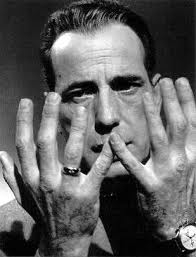
The hands of a killer writer?
We can look at these alterations as modifications created purely to heighten suspense and viewer expectations; but in an auteurist sense they also serve to expand our understanding of Nicholas Ray’s preoccupations with the emotionally conflicted male protagonist. If his heroes are invariably affected by their physical environment and the way in which it is presented to the viewer (and one invariably recalls the skewed perspectives expressing Jim’s turmoil in Rebel Without a Cause, 1955) then how do we explain the simplicity of some parts of his living space and why other parts are cluttered with pattern, disrupted with partitions and engulfed with motifs and flowers? The texture of the film offers blankness alternating with intense over-decoration –yet the interior of Paul’s, an industry haunt, is disappointing and hardly the equal of the real Romanoff’s. Perhaps this is the film’s sly comment on the industry’s intrinsic emptiness and fake attractions. The musical patterns and occasional songs and the self-consciously ‘movie’ dialogue with its smart rhythms and snide one-liners echo these shifts in perspective and living arrangements (we never see the studios despite this being a movie-movie). These men suffer an altogether modern problem, alienation. They get close to people but invariably shy away ultimately from intimacy on a permanent level; or when they attempt it, do something suicidally stupid to scupper it, as does Dix, when in a cataclysmic moment picking up the phone call meant for Laurel he finds out that she has obtained a cancellation on a flight to New York late that night. Another call is from Lochner and Brub, the call that is “gonna take a lot of tension off you and Laurel” and which Dix passes to Laurel with the line, “A man wants to apologise to you.” (It should have been him.) The phone calls that punctuate the drama are totems of modern convenience that both save and destroy lives, a play on the dramatic devices that are used to break up movie scenes and introduce conflict or new characters or alter the pace or shift the location (all of which they do in the film). He hasn’t killed her, but this discovery of her second betrayal will probably kill him. She is living with him but running away from him: he withdraws from her and he scares her. This is the emotional shape underlying the narrative weave. They simply cannot survive one another.
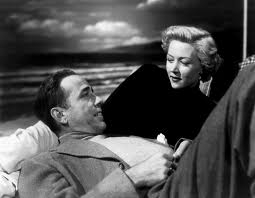
The calm before the storm
We might say that Ray’s heroes do constant battle between their instincts and their intellect: do we sympathise with Dix when he beats the quarterback and leaves him for dead at the roadside? We do –because we sense his anger at being the chief suspect for a crime we believe he has not committed – but his reaction to his situation once again inspires doubts. Ray’s heroes are volatile and honest – to a fault. Dix oscillates between smart wisecracks, outbursts of violence and periods of immense contrition characterised by acts of extreme kindness. His reflex action, when the boy’s name appears in the following morning’s headlines, is to head to the Post Office to send him a gift in apology and error – “from [the blind knuckleheaded] Mister Squirrel.” After being questioned the morning of Mildred’s murder he asks a florist to send her two dozen white roses. He is brutally honest and witty, with a gallows humour ill-befitting a man in his situation, at least to the merely humourless observer (can there be any more dangerous animal?). When he shakes hands with Kesler (Jack Reynolds), the real killer, yet to shoot himself and confess, Kesler comments, “What an imagination. That’s from writing movies”; while Dix rejoins with, “What a grip – that’s from counting money.” Kesler looks at him in bafflement. Dix’s character is too complex for the simpleminded – even the single-minded murderer takes exception to Dix’s exceptionalism and the suggestion that he, the man in love with Mildred, could have been her killer. Dix is compared constantly with other men – and he is presented as a product of the noir style which invokes the problematic protagonist, a neurotic, fiery, spiky, male whose masculinity is constantly being discovered, ignored, refined, whose aesthetic could well be masking its cultural obverse, violence. As Brub comments to Lochner, “It’s hard to tell how Dix feels about anything. None of us ever could figure him out.” When Dix regales Mel with his experience at the Beverly Hills Police Station he says, “It was his story against mine. I told my story better.” This is essentially a film about storytelling, as we are regularly reminded. Part two takes a closer look at the reflexive aspects of Ray’s In a Lonely Place.
Endnotes
fn. 1 On Dangerous Ground (Ray, 1951) concludes with a sequence which mirrors this: the image is similarly fragmented, with Robert Ryan’s eyes highlighted squinting in the rear-view mirror as we transition from him in a POV tracking shot in the country to one in the city at night. The affect is quite different: Ryan has now been softened by his relationship with Ida Lupino and is no longer the psychotic cop but a man of feeling with a blossoming relationship. The film is ending where In a Lonely Place commences, physically and essentially –another irony perhaps given the potshot Dix takes at the movie director at Paul’s when he snarls, “You’ve been making the same film over and over for 20 years.” (This is not something that would trouble the auteurists. Au contraire.)
Bibliography
BooksBasinger, Jeanine (2007). THE STAR MACHINE. New York: Vintage Books.
Belton, John (1994). AMERICAN CINEMA/AMERICAN CULTURE. New York: McGraw-Hill Inc.
Bordwell, David, Janet Staiger and Kristin Thompson (1994). THE CLASSICAL HOLLYWOOD CINEMA: Film Style and Mode of Production to 1960. London: Routledge.
Casper, Drew (2007). POSTWAR HOLLYWOOD 1946-1962. Malden, Massachusetts: Blackwell Publishing.
Dancyger, Ken and Jeff Rush (1990). ALTERNATIVE SCRIPTWRITING. New York: Focal Press.
Eisenschitz, Bernard (1996). NICHOLAS RAY: An American Journey. (Translated from the French by Tom Milne.) London: Faber & Faber.
Friedrich, Otto B. (1997). CITY OF NETS: A Portrait of Hollywood in the 1940s. Berkeley and Los Angeles: University of California Press.
Hughes, Dorothy B. (1947 [2003] ) IN A LONELY PLACE . New York: Feminist Press, City University of New York.
Krutnik, Frank (1991). IN A LONELY STREET: Film Noir, Genre, Masculinity. London/ New York: Routledge.
Naremore, James (2008). MORE THAN NIGHT: Film Noir In Its Contexts. Berkeley and Los Angeles: University of California Press.
Polan, Dana (1993). IN A LONELY PLACE . London: British Film Institute.
Sarris, Andrew (1968). THE AMERICAN CINEMA: Directors and Directions 1929-1968. New York: Da Capo Press.
Shiel, Mark (2012). HOLLYWOOD CINEMA AND THE REAL LOS ANGELES. Reaktion Books.
Telotte, Jean-Pierre (1989). VOICES IN THE DARK: The Narrative Patterns of Film Noir. Urbana: University of Illinois Press.
Thomson, David (1994). A BIOGRAPHICAL DICTIONARY OF FILM. London: Secker & Warburg.
Truffaut, François (1978). THE FILMS IN MY LIFE. (Translated by Leonard Mayhew) New York: Simon & Schuster.
Journal ArticlesBrooks, Louise. ‘Humphrey and Bogey,’ in Sight & Sound, Winter 1966/7, Vol. 36: 1. Accessed 26 October 2012.
Crowther, Bosley (1950). ‘In a Lonely Place,’ New York Times, 18 May 1950. Accessed 27 October 2012.
Ebert, Roger (2009). “In a Lonely Place,” Chicago Sun Times, 13 August 2009. Accessed 26 October 2012.
Gonzales, Ed (2001). “In a Lonely Place,” Slant magazine, 27 June 2001. Accessed 26 October 2012.
Lyman, Rick (2000). ‘A Dark Lesson in Trust,’ New York Times, 15 December 2000.
Place, Janey and Lowell Peterson (1974). ‘Some Visual Motifs of Film Noir,’ Film Comment, January-February 1974. Accessed 31 October 2012.
Rich, B. Ruby (1995). ‘Dumb Lugs and Femmes Fatales,’ Sight & Sound, Vol.5, No.11, November 1995: 6-10.
Thill, Scott (2003). “In a Lonely Place.” Bright Lights Film Journal, May 2003, Issue 40. Accessed 26 October 2012.
Schrader, Paul (1974). ‘Notes on Film Noir,’ Film Comment, Spring 1972. Accessed 30 October 2012.
Thomson, David (2003). ‘The Poet of Nightfall,’ The Guardian, 27 December 2003, Arts section: 16-17.
Variety, ‘I Like His Face,’ 17 May 1950. Accessed 26 October 2012.
Copyright
All film stills copyright Santana Productions/Columbia Pictures.



